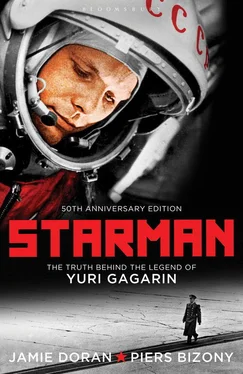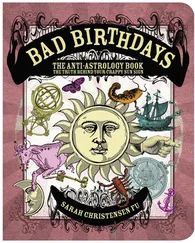Throughout all his years working to give the Soviets a lead in space, Korolev had never discussed his arrest, torture, beatings and imprisonment under the old Stalinist regime. People thought of him as a burly man, built like a bear, but the truth was that his body was made rigid by countless ancient injuries. He could not turn his neck, but had to swivel his upper torso to look people in the eye; nor could he open his jaws wide enough to laugh out loud.
Two days before he was scheduled for surgery he was resting at his home in the Ostankino district of Moscow. Gagarin and Leonov came to visit him with several other colleagues, and at the end of the evening, just as most of the visitors were putting on their greatcoats to leave, Korolev said to his two favourite cosmonauts, ‘Don’t go just yet. I want to talk.’ So his wife Nina fetched some more food and drink, and for four hours, well into the early hours of the morning, Korolev told the story of his early life – a story that Leonov has never forgotten. ‘He told us how he was arrested, taken away and beaten. When he asked for a glass of water, they smashed him in the face with the water jug… They demanded a list of so-called traitors and saboteurs [in the early rocket programme] and he could only reply that he had no such list.’ Korolev described how he saw, through puffy eyes, that his captors had pushed a piece of paper between his bruised fingers for him to sign; how they beat him again, and sentenced him to ten years’ hard labour in Siberia. ‘Yuri and I were both struck by the unexpected parts of his story,’ says Leonov.
From a living death in Siberia, Korolev was recalled to Moscow when an old ally of his, the renowned aircraft designer Andrei Tupolev, requested him for war work. He would be assigned to a less harsh special prison facility for engineers, which included design offices and better living conditions. [6] Harford, Korolev , pp. 49–63.
In fact, Tupolev was himself a prisoner. But no special arrangements were made to transport Korolev to Moscow, and he had to improvise. Cold beyond endurance and hallucinating with hunger, he found a hot loaf of bread on the ground one day, apparently dropped from a passing truck. ‘It seemed like a miracle,’ he told Gagarin and Leonov. He worked as a labourer and shoe repairer to earn his passage back to Moscow by boat and rail. His teeth were now loose and bleeding, because he had not eaten fresh fruit or vegetables in a year. Trudging along a dirt track one day, he collapsed. An old man rubbed herbs on his gums and propped his body to face the feeble sun, but he collapsed again. As Leonov vividly recalls, ‘He told us he could see something fluttering. It was a butterfly, something to remind him of life.’
It seems that after so many years’ silence the ailing Chief Designer now wanted to unburden himself to his two favourite young friends. The two cosmonauts were deeply affected by what they heard. Leonov says, ‘This was the first time that Korolev had ever talked about his imprisonment in the Gulag, since these stories are usually kept secret… We began to realize there was something wrong with our country… On our way home, Yuri couldn’t stop questioning: how could it be that such unique people like Korolev had been subjected to repression? It was so obvious that Korolev was a national treasure.’
After the funeral Gagarin insisted on spending the night at Korolev’s house. According to Yaroslav Golovanov, ‘Gagarin said, “I won’t feel right until I’ve taken Korolev’s ashes to the moon.” At the crematorium he asked cosmonaut Vladimir Komarov to scatter some of Korolev’s ashes on the next space flight, during the descent, although, according to Orthodox custom, you must not divide a person’s ashes.’ It is not clear whether any ashes were actually taken into space, but Golovanov insists that several handfuls went missing from the crematorium. ‘Komarov did scatter some of them after Korolev’s death. Gagarin and Leonov also had some ashes.’
Korolev’s death marked a turning point for Gagarin. He became totally recommitted to flying in space, and even to flying to the moon. His self-discipline returned, and he worked on his diploma with passionate energy. He impressed Kamanin, who allowed him to train as back-up for the first Soyuz mission. All being well, the back-up position would automatically entitle Gagarin to the second Soyuz flight. But this put him in direct conflict with another cosmonaut, who believed that the assignment belonged to him, not to Gagarin. The noted space historian James Oberg says, ‘This tension between Gagarin and one or two of the cosmonauts isn’t written about very much, perhaps because people don’t like to talk about it. Basically Gagarin pulled rank.’ [7] Conversation with James Oberg.
Most of the cosmonauts got on well with Gagarin, appreciated his humour and generosity of spirit, enjoyed drinking and partying with him and deferred to him as the undisputed leader of their cause. Many were anxious to see him back in space, but one cosmonaut in particular felt differently.
Georgi Timofeyevich Beregovoi, born in April 1921, was one of the oldest cosmonauts, recruited in 1963 when the list of ‘near-misses’ among the original 1959 candidates was re-evaluated. Among all the cosmonauts, only he and Pavel Belyayev (Leonov’s commander on the Voskhod II mission) could claim the greatest distinction for a pilot: experience in real aerial combat. Beregovoi flew 185 missions against the Germans during the war, and was awarded the much-prized title Hero of the Soviet Union. During the 1950s he served as a test pilot, so when he signed up for cosmonaut training he believed he was well qualified. In 1964, quite soon after his selection, he gained a back-up posting for the planned Voskhod III mission and trained with every confidence that he would fly whatever mission came next. Nikolai Kamanin felt at ease with a fellow war veteran. He sponsored Beregovoi’s recruitment and gave him every chance to succeed.
After Korolev’s death, his deputy Vasily Mishin took over the administration of OKB-1. He was good-natured and eager, but he lacked the political influence and raw cunning of his predecessor. [1] For a valuable account of Mishin’s troubles, see Sagdeev, Roald, The Making of a Soviet Scientist , New York: John Wiley & Sons, 1994, pp. 123–4, 179–81.
One way and another, the Voskhod III schedule slipped so badly that it had to be cancelled. Mishin decided to focus OKB-1’s energies on Soyuz and on the further, very troubled development of the large moon booster, the N-1.
Beregovoi now expected his back-up status to be shuffled smoothly along to the next mission, the first manned test of the new Soyuz configuration. At this point Gagarin stepped in and claimed that posting for himself, making every possible use of his rank as Deputy Director of Cosmonaut Training to do so. Beregovoi made his annoyance crystal-clear to anyone who would listen, and eventually stormed into Gagarin’s office at Star City for a direct confrontation. Gagarin’s driver Fyodor Dyemchuk walked into the office at the wrong moment and overheard the row. ‘The other man was the superior in years, but he hadn’t flown into space yet. He made indecent remarks about Gagarin, and said he was too young to be a proper Hero of the Soviet Union and he’d become conceited. He called Gagarin an upstart, and Gagarin replied, “While I’m in charge, you’ll never fly in space.” They argued for quite a while.’
There seems to have been some fault on both sides. Beregovoi was not automatically entitled to a Soyuz mission, despite what he may have thought. His training on the very different Voskhod hardware was completely inappropriate for the new ship, and he had no right to take out his run of bad luck on Gagarin, just because the Voskhod series had been brought to a close before he could fly. Judging from the fact that he rose to become Head of Star City in 1972, Beregovoi was an ambitious man.
Читать дальше












